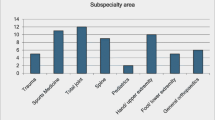Abstract
Patients who suffer osteoporotic fractures do not typically receive medical/pharmaceutical treatment for osteoporosis. Orthopedic surgeons are concerned about, but not always diligent in following up on, the medical treatment of their fracture patients. The objective of this study was to determine whether orthopedic surgeons could effectively and consistently refer patients with osteoporotic fractures to a primary care provider (PCP) for possible work-up and treatment of osteoporosis. Fourteen orthopedic surgeons participated in the program. Sixty-nine qualifying patients were ≥50 years old, had a low-energy fracture, and had no prior treatment for osteoporosis. For each patient, two letters requesting a PCP appointment were sent to their PCP: one within 10 days of fracture and another 3–10 weeks after fracture. Patients were also instructed that they might have osteoporosis, and were directed to see their PCP. Results showed that of 69 patients (59 females, ten males: average age 69.5±10.9 years), 30 (43.5%) did not see a PCP within 84 days. Thirty-nine (56.5%) patients saw a PCP within 84 days, but osteoporosis was not addressed in four (average days to PCP, 39.8±18.6: range 7–78 days). Of patients seen within 84 days, anti-resorptive medications (e.g. bisphosphonate) were started in 21/39 (53.8%), but typically not within 41 days of fracture. Of the 14 orthopedic surgeons, five were non-compliant and seven were inconsistent in their participation, forgetting to send the letters and/or inform patients to make PCP appointments. Standing discharge orders (for medications, PCP follow-up, bone-density scanning, etc.) may be more effective in achieving timely medical treatment for patients of orthopedic surgeons with osteoporotic fractures.


Similar content being viewed by others
References
Torgerson DJ, Dolan P (1998) Prescribing by general practitioners after an osteoporotic fracture. Ann Rheum Dis 57:378–379
Freedman KB (1999) Osteoporosis prevention and the orthopaedic surgeon: when fracture care is not enough (editorial response). J Bone Joint Surg 81:1652–1653
Pal G (1999) Questionnaire survey of advice given to patients with fractures. BMJ 318:500–501
Broy SB, Bohren A, Harrington T, Licata A, Shewman D (2000) Are physicians treating osteoporosis after hip fracture? J Bone Miner Res 15:S141
Freedman KB, Kaplan FS, Bilker WB, Strom BL, Lowe RA (2000) Treatment of osteoporosis: are physicians missing an opportunity? J Bone Joint Surg [Am] 82:1063–1070
Cuddihy MT, Gabriel SE, Crowson CS et al. (2002) Osteoporosis intervention following distal forearm fractures: a missed opportunity? Arch Int Med 162:421–426
Gardner MJ, Flik KR, Mooar P, Lane JM (2002) Improvement in the undertreatment of osteoporosis following hip fracture. J Bone Joint Surg [Am] 84-A:1342–1348
McClung MR, Geusens P, Miller PD et al. (2001) Effect of risedronate on the risk of hip fracture in elderly women. N Engl J Med 344:333–340
Lindsay R, Silverman SL, Cooper C et al. (2001) Risk of new vertebral fracture in the year following a fracture. JAMA 285:320–323
Liberman UA, Weiss SR, Broll J et al. (1995) Effect of oral alendronate on bone mineral density and the incidence of fractures in postmenopausal osteoporosis. N Engl J Med 333:1437–1443
Fleisch H (2001) Can bisphosphonates be given to patients with fractures? (editorial). J Bone Miner Res 16:437–440
Smith R (1991) Osteoporosis at the Tivoli. J Bone Joint Surg [Br] 73-B:525–526
Tosi LL, Lane JM (1998) Osteoporosis prevention and the orthopaedic surgeon: when fracture care is not enough (editorial). J Bone Joint Surg [Am] 80-A:1567–1569
Pal B, Morris J, Muddu B (1998) The management of osteoporosis-related fractures: a survey of orthopaedic surgeons’ practice. Clin Exp Rheum 16:61–62
Lane JM, Nydick M (1999) Osteoporosis: current modes of prevention and treatment. J Am Acad Orthop Surg 7:19–31
Skedros JG, Milleson NM, Holyoak JD (2003) Knowledge and opinions of orthopaedic surgeons concerning initiation of treatment for patients with osteoporotic fractures. Trans Orthop Res Soc 28:1058
Edwards BJ, Bunta A, Madison L, Ramsey-Goldman R, Taft L (2000) A fracture intervention program: First year results. J Bone Miner Res 15:S537
Ridout R, Hawker GA, Mahomed N, Bogoch ER (2000) An intervention to increase investigation and treatment of osteoporosis in fragility fracture patients. J Bone Miner Res 15:S294
McLellan AR, Fraser M (2002) A 28 month audit of the efficacy of the fracture liaison service in offering secondary prevention for patients with osteoporotic fractures. J Bone Miner Res 17:S358
Fonarow GC, Gawlinski A, Moughrabi S, Tillisch JH (2001) Improved treatment of coronary heart disease by implementation of a cardiac hospitalization atherosclerosis management program (CHAMP). Am J Cardiol 87:819–822
Acknowledgements
This study was completed with the assistance of orthopedic surgeons in northern and central Utah. The author thanks Dr. Dustin Hunsaker, Joshua Holyoak, Niki Milleson, Geri Henderson and Cyndi Slot for their help in completing this project, and are grateful for the critical reviews of Dr. Philip A. Kithas, Dr. Mark W. Mason, Dr. Kenneth J. Hunt, and Dr. Tony Y. Kuo. This study was supported by a grant from Merck and Co., Inc. and by the Utah Osteoporosis Center, Salt Lake City, Utah.
Author information
Authors and Affiliations
Corresponding author
Rights and permissions
About this article
Cite this article
Skedros, J.G. The orthopaedic surgeon’s role in diagnosing and treating patients with osteoporotic fractures: standing discharge orders may be the solution for timely medical care. Osteoporos Int 15, 405–410 (2004). https://doi.org/10.1007/s00198-003-1561-6
Received:
Accepted:
Published:
Issue Date:
DOI: https://doi.org/10.1007/s00198-003-1561-6




